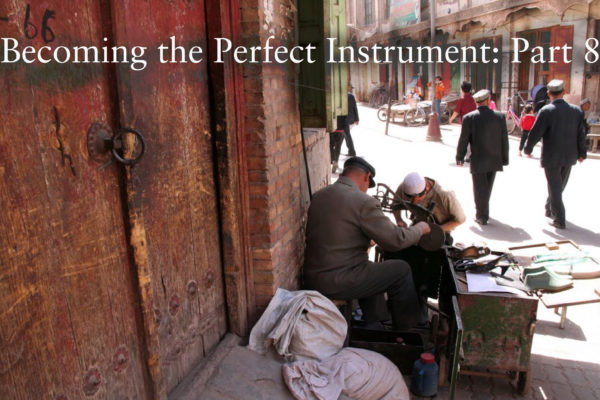
In my last post, I wrote about what it means to think in terms of developing client relationships, as a way of being, rather than focusing on developing business. This connects to the question of building a network, which many people who value depth and authenticity struggle with, because they feel that what’s required to build a broad and valuable network is at odds with their style and even their character.
I don’t experience this to be true. I’ll share more about my own experience in a separate post down the road, but here would like to share the practices that we strive to make consistent in our own work at Incandescent, as they can provide a more general roadmap to a deeply generous, authentic approach to network development.
Although from time to time, opportunities arise because someone who doesn’t know us at all reaches out based on reputation, an article that’s caught their eye, or the like, the lion’s share of new business opportunity comes through people we know – whether directly or through their decision to refer us to people they know. The way we grow our business is therefore significantly a function of the properties of our network.
This makes how we network an existential question for Incandescent. What I mean isn’t just a matter of “more is better” (even a firm of fifteen people needs a certain flow of business), but a deeper question of identity. The nature of the opportunities we encounter flows from the qualities of the people who know us well and the particular frames through which these people think of us. These opportunities then further shape who we as a firm come to be. This is a cycle – and to speak for a moment purely in personal terms, since I plan to spend the rest of my career building Incandescent, making it a virtuous cycle feels like a “life imperative,” not just a business imperative.
Given what’s at stake, the deeper “how” of network building is even more important than the business “what.” Nine principles serve as a compass.
- Be generous. Try to make sure that people who touch us are made in some way – even a very small way – better off: that they take away an idea, an introduction, a useful tool, something that helps them with what they care about.
- Listen beautifully. Pay attention to what people really care about, underneath whatever’s on their mind right now. Don’t just produce insights, but talk with people in ways that draw new insights from them.
- Treat people as clients. Given our commitment to treating the client relationship[1] as a way of being, rather than as a transaction, “trying on” the shared agenda of helping someone achieve their aspirations should flow naturally from the way we have conversations. In most cases, this stance will have nothing to do with developing business, but it will cause a range of people to experience the feeling and the practical result of having their aims and their success valued.
- Focus on the long term. In both what we say and how we act, demonstrate commitment to the long arc of relationships. This manifests in terms of caring enough and being disciplined enough to keep in touch with people we’ve come to know in one context, over many years and in many contexts. Often sustained small gestures – reaching out once or twice per year for many years – matter more over the long term than large gestures without continuity. Equally, this means when we’re getting to know new people, we should focus on the longer arc of what matters to them, rather than just the exigencies of their situation at hand.
- Connect. We should create value through relationships as well as through ideas. This means thinking about whom we know who might be of value to the person we’re engaging with, and, where we think there will be a genuinely mutual value in meeting, make the connection. This creates value in four ways. First (and least important), this is often an extremely efficient way of creating value. Second, we demonstrate that we don’t want to help someone just through what we can do, but more broadly through paying attention to what they need. Third, as two people we’ve introduced meet, this is generally an occasion for them to reaffirm and reinforce for each other what they each value about us. Finally, by introducing people to others who can help them, we model having a relationship in which they also think about who might be helpful to us. This should never be a quid pro quo, simply a reciprocity that emerges when it’s natural and it should.
- Invest in communities. The strengths of our way of being come to the fore when we’re part of communities that reflect parallel principles. We should be especially proactive about investing in making a positive difference to groups of mutually interconnected people whose values reflect our own and whose business interests powerfully intersect with ours. Some of these communities may take an explicit, institutional form (e.g., World Economic Forum Young Global Leaders, Acumen’s advisor network and +Acumen community); some will be quite informal, but no less real (e.g., a network of people interested in strategic approaches to talent management who exchange ideas and collaborate in various ways). Generally, these networks will have hubs, and investing time in being helpful to these hubs – or becoming hubs where that makes sense – can be just as impactful as investing in relationships with leaders who are positioned to be clients.
- Teach by example who we are. We work hard to make each touchpoint with the firm expressive of who we are. These touchpoints become more valuable when we also use them as opportunities to teach people about our ideas and our values. This means explaining how something that the other person is already experiencing in a positive way fits into the broader framework of how we think, how we operate and what we do.
- Ask for help. We spend a great deal of our time helping others. We shouldn’t be shy about asking others for help. If they say no, we can decide whether that says anything important about the relationship, or is simply something to let pass. Over the long term, we’ll do best by helping generously, by giving others the opportunity to help us, and by focusing most on relationships where there is real mutuality and reciprocity.
- Master the graceful no and the bounded yes. One outcome of following these principles is that they can create a great many demands on one’s time: actions we might do to help people, time spent with people from many periods in our past, introductions to new people whom others connect us to, etc. All these things are good – and, of course, they can also become overwhelming.
We shouldn’t hesitate to say a graceful no. Generosity does not compel saying yes to things when we best serve our values by focusing scarce time and resources elsewhere. Graceful simply means we honor the relationship and own our “no” – as in “I admire what you’re trying to do in building X. I know Y [person you’re looking to get introduced to] is very busy and don’t think this is an ask that it makes sense for me to make of her right now. Please do keep me in the loop about the progress you’re making. I’m impressed with the traction you’re already getting with Z.”
Equally important is the “bounded yes” in which we say yes to something that we believe it makes sense to do, while drawing a clear boundary that keeps us from being drawn into commitments we don’t want to make. For instance, if we’re in the early exploration phase of working with an entrepreneur who is in the midst of raising capital, and it is clear that we don’t or don’t now want to take on a large advisory and potentially investment commitment, one might say: “I think our primary value here is to be a sounding board from time to time at critical junctures, which will enable us all to stay close enough to identify if there are larger opportunities to pursue together. Let’s talk when [some larger triggering event happens]. We’re not in a position to make cash investments, except in a tiny number of situations where we are also core long term advisors, so we’ll have to decline the opportunity to participate in [your investment round].”
Part of what this boils down to is getting beyond a primary focus on optimizing the cost-benefit trade-off of each relationship, to building a constellation of relationships that will create the right kind of value in the right way over the long term. This doesn’t mean that we can’t be transactional when we need to be that way – and certainly not that we can’t focus rigorously on our goals and interests in the transactions we do. Rather, these principles reflect our aspirations for how we want to be out in the world, so that we can build a business by being our best selves.
Building a network in this way takes time. In sharing this advice with people earlier in their careers, it’s helpful to think of this as the growth of a woodland – tangled, organic, complex, encompassing the variety of life – not the growth of a cornfield. Different relationships provide different forms of practice, and practicing in this range of ways makes us better. I’ve generally found that someone who takes this set of principles to heart and approaches relationships in this way will grow their network at more or less the speed at which they develop the other capabilities required to achieve their aspirations. If that rough empirical observation is accurate, it points to something profoundly optimistic: that a practice of being one’s best and giving generously, pursued thoughtfully and with discipline over time, not only creates the basis for lasting success, but builds a fabric of relationships that reflects one’s values and gives work’s hours and work’s years vibrancy, and depth, and life.
[1] As explored in my post “Don’t Develop Business, Develop Clients,” we believe that the heart of the client-advisor relationship is commitment to a shared agenda to realizing what the client seeks to achieve. The advisor must begin from the client’s purpose, and the client must be willing to make that purpose shared.



